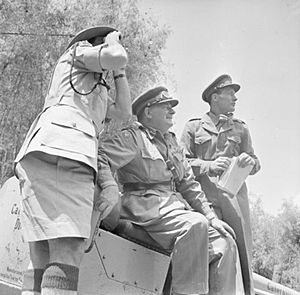East Africa Command facts for kids
Quick facts for kids East Africa Command |
|
|---|---|

Formation Sign
|
|
| Active | 1940–1963 |
| Country | |
| Branch | |
| Type | Command |
| Part of | Middle East Land Forces (1947–1963) |
| Garrison/HQ | Nairobi |
The East Africa Command was a special military group of the British Army. It was set up to manage British forces in East Africa. Until 1947, it reported directly to the Army Council in Britain. After that, it became part of the larger Middle East Command. The East Africa Command was closed down on 11 December 1963. This was just one day before Kenya became an independent country. It was replaced by a temporary group called British Land Forces Kenya. This group's job was to help all remaining British troops leave the area. By December 1964, all British troops had left, and British Land Forces Kenya was also closed.
Contents
History of the Command
Starting the Command
As World War II seemed likely in the late 1930s, the British expanded their local army in East Africa. This army was called the King's African Rifles (KAR). More soldiers and support units were added in 1939.
When Italy joined the war in June 1940, Major-General Douglas Dickinson was put in charge of the East Africa Force. His job was to protect Kenya. He also needed to keep as many Italian soldiers busy on his front as possible. Fighting with the Italians began in June 1940 near Moyale, on Kenya's northern border. This was the start of the East African Campaign (World War II).
General Dickinson's force included troops from Kenya, Tanganyika, Nyasaland, and Rhodesia. More soldiers arrived from South Africa and West Africa. With these new troops, two large groups of soldiers, called divisions, were formed on 19 July. The 1st (African) Division protected the coast. The 2nd (African) Division watched over Kenya's northern border, facing Ethiopia.
Growth and Changes
In September 1941, the East African Force became an official "Command." It was led by General Sir William Platt. This new Command covered North East Africa, East Africa, and British Central Africa. Until 1944, it also guided the British Military Mission in Ethiopia.
Between 1947 and 1950, a huge British military storage base was built at Mackinnon Road. It was meant to hold 200,000 tons of military supplies. Britain expected to lose its military bases in Egypt because of rising nationalism there. So, they needed a new place to store supplies that had been in the Suez Canal Zone. However, this plan was later stopped. The base then became a place to hold people suspected of being involved in the Mau Mau rebellion until 1955.
Later, the Command was reorganized. It lost control over some units. This happened because the new Central African Federation took over the KAR units in Northern Rhodesia and Nyasaland.
The Mau Mau Uprising
The East Africa Command created its own spy network during the Mau Mau Uprising in 1952. During this time, the Command controlled several brigades (groups of soldiers). These included the 39th, 49th, and 70th (East African) Infantry Brigades.
In February 1953, the 39th Brigade was told to get ready to go to Kenya. It arrived in April 1953 and was sent to the Rift Valley. After more than a year of operations, these soldiers were replaced by new ones in late 1954 and early 1955. The 39th Infantry Brigade left Kenya in 1956. The 49th Brigade took control of the local Kenya Regiment.
Many different British army units were in Kenya from 1952 to 1956. These included training schools and various police groups. Several King's African Rifles battalions were also there.
End of the Command
The 24th Infantry Brigade helped share intelligence across East Africa. It stayed until October 1964, when it moved to Aden.
British Land Forces Kenya
The East Africa Command officially closed on 11 December 1963. This was the day before Kenya became independent. It was replaced by British Land Forces Kenya the very next day.
In late 1963, there was still unrest in Kenya's north-east region. This led President Kenyatta to hold an urgent meeting. Major-General Ian Freeland, who was in charge of British Land Forces, attended. After the meeting, the government declared a state of emergency in the region. They also created a special zone along the Kenya-Somalia border.
The 70th (East African) Brigade became the foundation for the new independent Kenya Army. Many units, including three King's African Rifles battalions, were handed over to the new Kenya Army. This happened during Kenya's independence in December 1963 and January 1964.
The 24th Infantry Brigade helped Britain respond to army mutinies. These mutinies broke out in Zanzibar, Tanzania, Uganda, and Kenya itself in January 1964. For example, when soldiers in Tanganyika rebelled, British troops were quickly sent in. The 1st Battalion, Staffordshire Regiment, was sent to Jinja after the Uganda Army mutiny.
Military leaders in Kenya took these mutinies very seriously. They quickly made plans to deal with similar problems. This meant they had more resources to prevent and handle issues within the Kenyan army.
However, trouble still broke out on 24 January 1964 within the 11 Kenya Rifles at Lanet Barracks. The uprising was quickly stopped. The 11 Kenya Rifles unit was eventually disbanded.
The last British unit to leave Kenya was the 1st Battalion, Staffordshire Regiment, on 10 December 1964. British Land Forces Kenya stopped existing on 12 December 1964. All British Army forces, except for a small group handling paperwork, left the country. Operations against anti-"Shifta" groups continued, but now under the control of the Kenya Army.
Commanders-in-Chief

Here are some of the main commanders: GOC East Africa Force
- c. September 1939–1940 Lieutenant General Douglas Dickinson
- 1940–1941 Lieutenant General Sir Alan Cunningham
- Aug – Dec 1941 Major-General Harry Wetherall
GOC East Africa Command
- 1941–1945 Lieutenant General Sir William Platt
- 1945–1946 Lieutenant General Sir Kenneth Anderson
- 1946–1948 Major General William Dimoline
- 1948–1951 Lieutenant General Sir Arthur Dowler
- 1951–1953 Lieutenant General Sir Alexander Cameron
- 1953–1955 General Sir George Erskine
- 1955–1957 Lieutenant General Sir Gerald Lathbury
- 1957–1960 Major General Sir Nigel Tapp
- 1960–1963 Major-General Sir Richard Elton Goodwin
- 1 November 1963–11 December 1963 Major General Ian Freeland
GOC British Land Forces Kenya
- 12 December 1963 - 28 November 1964 Major General Ian Freeland.

